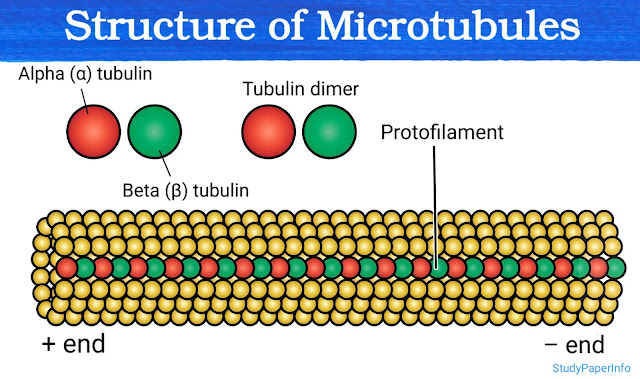Define the microtubules
Microtubules are hollow, cylindrical structures present in the cytoplasm of all eukaryotic cells. They are one of the three main components of the cytoskeleton, along with microfilaments and intermediate filaments. Microtubules are dynamic, meaning they can continuously grow and shrink as per the cell's requirement. They are mainly composed of tubulin proteins and play several essential roles in cellular structure, movement and division. Their constant assembly and disassembly help the cell to change shape, move materials and divide properly.
Origin, Composition and Structure of Microtubules:
Microtubules always arise from a specific region inside the cell known as the Microtubule Organizing Center (MTOC). In animal cells, this center is called the centrosome, which is found close to the nucleus. From this central region, microtubules start growing and extend outward into the cytoplasm. In dividing cells, another temporary organizing structure called the spindle pole also helps in forming microtubules that are used during mitosis. In plant cells, although centrosomes are not present, microtubules still originate from certain regions near the nucleus and around the nuclear envelope. This origin point acts as an anchoring site where the minus ends of microtubules are fixed and the plus ends grow outward.
Now talking about the composition, microtubules are made up of tubulin proteins, which are small, globular proteins. These proteins come in two forms: alpha-tubulin and beta-tubulin. One alpha and one beta tubulin molecule join to form a stable pair called a heterodimer. These heterodimers are the building blocks of microtubules. They keep joining one after another to form a long chain called a protofilament.
Structurally, a single microtubule is a hollow, tube-like cylinder. It is built from 13 parallel protofilaments arranged in a circle, forming the wall of the hollow tube. The overall diameter of a microtubule is about 25 nanometers. This hollow structure gives both mechanical support and flexibility to the cell. Each protofilament has a specific direction or polarity, with a fast-growing plus (+) end and a slow-growing or disassembling minus (–) end. This polarity is very important for the movement of motor proteins and cellular transport.
Another special feature of microtubules is their dynamic nature, which means they can quickly grow or shrink depending on the needs of the cell. This behavior is called dynamic instability, and it allows the cell to reorganize its internal structure during processes like cell division, growth and repair.
Functions of Microtubules
Microtubules are involved in many crucial cellular functions. These are described under different categories:
1. Maintenance of Cell Shape:
- Microtubules form a supportive framework that helps the cell maintain its three-dimensional shape and resist compression forces.
2. Intracellular Transport:
- Microtubules act like highways for transporting substances within the cell. Motor proteins like kinesin and dynein move along them, carrying vesicles, organelles, and other materials to different parts of the cell.
3. Chromosome Movement in Cell Division:
- During mitosis and meiosis, microtubules form the mitotic spindle. This structure pulls chromosomes apart and ensures proper segregation into daughter cells.
4. Formation of Cilia and Flagella:
- Microtubules form the internal structure of cilia and flagella, which are hair-like structures that help in movement (e.g., sperm cells) or in moving fluids over the cell surface (e.g., in the respiratory tract).
5. Positioning of Organelles:
- Microtubules help in holding organelles like the Golgi apparatus and endoplasmic reticulum in their correct positions within the cytoplasm.
6. Signal Transmission and Structural Reorganization:
- Their dynamic nature allows them to rapidly change in response to external signals. This flexibility helps the cell to reorganize itself when needed during development or repair.



Comments
Post a Comment